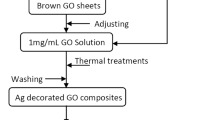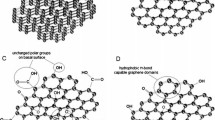Abstract
We prepared graphene(GE) with a mean size of 3087 nm. The transition of graphene oxide (GO) to GE was confirmed by UV-visible spectroscopy, Fourier transform infrared spectroscopy (FTIR) and X-ray diffraction (XRD). The experimental results of optical microscopic observation indicated that the GE ranged from 5 to 20 μg /mL did not affect the cell morphologies of the PC12 cells. The results of cell viability and membrane integrity assay supported that of optical microscopic observation and demonstrated that the GE ranged from 5 to 20 μg/ mL presented no obvious cytotoxicity. However, reactive oxygen species (ROS) assay suggested that an elevation of ROS level could be detected when the GE ranged from 20 to 100 μg/ mL. These results showed that the GE ranged from 5 to 10 μg/ mL presented an excellent in vitro biocompatibility and was one kind of potential biomaterials for neural tissue engineering.
Similar content being viewed by others
References
Geim AK. Graphene: Status and Prospects[J]. Science, 2009, 324(5934): 1530–1534
Zhu Y, Murali S, Cai W, et al. Graphene and Graphene Oxide: Synthesis, Properties, and Applications[J]. Advanced Materials, 2010, 22(35): 3906–3924
Han MY, Ozyilmaz B, Zhang Y, et al. Energy Band-gap Engineering of Graphene Nanoribbons[J]. Physical Review Letters, 2007, 98(20): 206805
Loh KP, Bao Q, Ang PK, et al. The Chemistry of Graphene[J]. Journal of Materials Chemistry, 2010, 20(12): 2277–2289
Ma WS, Li J, Deng BJ, et al. Properties of Functionalized Graphene/ Room Temperature Vulcanized Silicone Rubber Composites Prepared by an In-situ Reduction Method[J]. Journal of Wuhan University of Technology-Mater. Sci. Ed., 2013, 28(1): 127–131
Li JY, Li N, Li CJ, et al. Two-step Synthesis of Sulfur/Graphene Composite Cathode for Rechargeable Lithium Sulfur Batteries[J]. Journal of Wuhan University of Technology-Mater. Sci. Ed., 2015(1): 10–15
Kumar S, Raj S, Kolanthai E, et al. Chemical Functionalization of Graphene to Augment Stem Cell Osteogenesis and Inhibit Biofilm Formation on Polymer Composites for Orthopedic Applications[J]. ACS Appl. Mater. Interfaces, 2015, 7(5): 1–7
Liu Z, Robinson JT, Sun X, et al. PEGylated Nanographene Oxide for Delivery of Water-insoluble Cancer Drugs[J]. Journal of the American Chemical Society, 2008, 130(33): 10876–10877
Wu J, Wang YS, Yang XY, et al. Graphene Oxide Used as a Carrier for Adriamycin Can Reverse Drug Resistance in Breast Cancer Cells[J]. Nanotechnology, 2012, 23(35): 355101
Langer R, Vacanti JP. Tissue Engineering[J]. Science, 1993, 260(5110): 920–926
Chen GY, Pang DW, Hwang SM, et al. A Graphene-based Platform for Induced Pluripotent Stem Cells Culture and Differentiation[J]. Biomaterials, 2012, 33(2): 418–427
Lu B, Li T, Zhao H, et al. Graphene-based Composite Materials Beneficial to Wound Healing[J]. Nanoscale, 2012, 4(9): 2978–2982
Rossi F, Cattaneo E. Opinion: Neural Stem Cell Therapy for Neurological Diseases: Dreams and Reality[J]. Nature Reviews Neuroscience, 2002, 3(5): 401–409
Park SY, Park J, Sim SH, et al. Enhanced Differentiation of Human Neural Stem Cells into Neurons on Graphene[J]. Advanced Materials, 2011, 23(36): H263–H267
Tang M, Song Q, Li N, et al. Enhancement of Electrical Signaling in Neural Networks on Graphene Films[J]. Biomaterials, 2013, 34(27): 6402–6411
Zhou P, Wei H, Sun Q, et al. The Tunable Electrical Properties of Graphene Nano-bridges[J]. Journal of Materials Chemistry, C, 2013, 1(14): 2548–2552
Li Y, Liu Y, Fu Y, et al. The Triggering of Apoptosis in Macrophages by Pristine Graphene Through the MAPK and TGF-beta Signaling Pathways[J]. Biomaterials, 2012, 33(2): 402–411
Gurunathan S, Han J, Park JH, et al. An in vitro Evaluation of Graphene Oxide Reduced by Ganoderma spp. in Human Breast Cancer Cells (MDA-MB-231)[J]. International Journal of Nanomedicine, 2014, 9(9): 1783–1797
Yang XY, Wang XB, Jing L, et al. Controllable Reduction and Structural Characterizations of Graphene Oxides[J]. Chemical Journal of Chinese Universities, 2012, 33(9): 1902–1907
Kumar NA, Choi HJ, Shin YR, et al. Polyaniline-grafted Reduced Graphene Oxide for Efficient Electrochemical Supercapacitors[J]. ACS. Nano., 2012, 6(2): 1715–1723
Gurunathan S, Han JW, Kim JH. Green Chemistry Approach for the Synthesis of Biocompatible Graphene[J]. Journal of Materials Science, 2013, 8(16): 2719–2732
Liao KH, Lin YS, Macosko CW, et al. Cytotoxicity of Graphene Oxide and Graphene in Human Erythrocytes and Skin Fibroblasts[J]. ACS Appl. Mater. Interfaces, 2011, 3(7): 2607–2615
Chang Y, Yang ST, Liu JH, et al. In vitro Toxicity Evaluation of Graphene Oxide on A549 Cells[J]. Toxicology Letters, 2011, 200(3): 201–210
Nel A, Xia T, Madler L, et al. Toxic Potential of Materials at the Nanolevel[J]. Science, 2006, 311(5761): 622–627
Gurunathan S, Han JW, Eppakayala V, et al. Green Synthesis of Graphene and Its Cytotoxic Effects in Human Breast Cancer Cells[J]. International Journal of Nanomedicine, 2013, 8(1): 1015–1027
Author information
Authors and Affiliations
Corresponding author
Additional information
Funded by the Natural Science Foundation of Hubei Province (No.2014CFB839), the Doctoral Research Fund of Wuhan University of Technology (No.471-40120093), the Opening Project of Jiangsu Provincial Key Laboratory of Silk Engineering (No.KJS1415), the Hong Kong, Macao and Taiwan Science & Technology Cooperation Program of China (No.2015DFH30180), the Fundamental Research Funds for the Central Universities (No.WUT:2014-VII-028), the National Natural Science Foundation of China (No. 51403168) and the Key Project of Science and Technology of Wuhan (No. 2014060202010120)
Rights and permissions
About this article
Cite this article
Yi, J., Zhao, Z., Li, S. et al. In vitro biological evaluation of graphene on neuronal cells. J. Wuhan Univ. Technol.-Mat. Sci. Edit. 31, 925–930 (2016). https://doi.org/10.1007/s11595-016-1469-6
Received:
Accepted:
Published:
Issue Date:
DOI: https://doi.org/10.1007/s11595-016-1469-6




